|
Iconic Beauty:
The Golden Age of Hollywood Films
Was Also the
Golden Age of Celebrity Photos
By Hector Cantu
Reprinted from Heritage Magazine
Posted 10/2010
Shortly after movies began hitting the big screen, studios were using staff and freelance photographers to produce images of the day’s top stars. The most common were 8-by-10-inch stills distributed to newspapers, magazines, movie theaters and fans.
"A studio publicity department would set up a shot and select the images they wanted," says Simon Crocker, chairman of the John Kobal Foundation, a London-based group dedicated to Hollywood fine art photos and portraits. "These would be printed by the thousands. Captions and studio logos were typically printed on the photos."
Larger celebrity portraits, ranging from 11-by-14 inches to 16-by-20 inches, were made for specific purposes, Crocker says. "Photographers were asked to do exclusive prints, maybe for a specific magazine like Vanity Fair or another up-market magazine."
From these photo sessions, a portrait was selected by the photographer or with the photographer’s approval. Then, a limited number of prints was developed – often by the photographer himself – on high-quality paper.
"Extra portraits might be printed for studio executives or the stars," Crocker says. “Greta Garbo had sets delivered as part of her contract.” Most of these photos have the photographer’s personal stamp.
The collector market primarily focuses on these larger prints, says Grey Smith, director of Hollywood movie posters and photos at Heritage Auction Galleries.
"Celebrity portraits are more desirable," Smith says. "Whatever the size, these photos were all done for glamour. It was part of the Hollywood machine, telling everyone, 'We have the most beautiful stars.'"
Accomplishing that task were camera artists such as George Hurrell, Robert Coburn, Ruth Harriet Louise, Clarence Sinclair Bull, Ernest Bachrach and Otto Dyar. These photographers helped create the magic of Hollywood, says Karen Sinsheimer, curator of photography at the Santa Barbara Museum of Art.
"People like George Hurrell established a whole new way of doing portraiture," says Sinsheimer, who worked on the John Kobal Foundation’s "Made In Hollywood" exhibit, which showcases more than 90 prints by Hollywood’s greatest portraitists. The exhibit is showing at the Hood Museum of Art at Dartmouth College, in Hanover, N.H., through Sept. 12, 2010.
These images "…absolutely were the beginning of fashion photography," says Crocker. "What we see today is straight out of what Hurrell created. Pre-Hurrell, portraiture was almost theatrical and rigid and unsexy. Hurrell brought glamour and sex and the close-up. He created a look that has never really been improved upon."
Another allure is how these still images capture Hollywood’s most enduring stars – maybe in a way more powerful than film.
"What people remember of those stars is not from films, but one essential photograph," actress Louise Brooks (1906-1985) is quoted as saying in the book Ruth Harriet Louise and Hollywood Glamour Photography (University of California Press, $35). "When I think of Garbo, I do not see her moving in any particular film. I see her staring mysteriously into the camera. No matter how many times I’ve seen her in films, that is how I always see her. She is a still picture – unchangeable."
THE PHOTOGRAPHERS
The Golden Age of Hollywood portraiture began in 1920 and lasted for 40 years, according to the book Glamour of the Gods by Robert Dance and John Taylor (Steidl & Partners, $65). The accumulated work of Hollywood’s greatest photographers, the book argues "…is perhaps the most perfect record available of the history of Hollywood's first 50 years."
George Hurrell (1904-1992): One of Hurrell's first subjects was the famed aviatrix Poncho Barnes, reports the website HurrellPhotography.com. Through her, he met silent-screen star Ramon Novarro, who commissioned a series of portraits from Hurrell. Thrilled with the results, Novarro showed his stills to co-workers at Metro-Goldwyn-Mayer, and he was soon hired as head of the MGM portrait gallery in 1930.
James Abbe (1883-1973): In 1932, Abbe was the only American given permission to photograph Joseph Stalin, and eventually, photographing world leaders became his specialty, according to the book James Abbe: Shooting Stalin (Steidl/Museum Luwig, $50). He made contact with Russian film directors and artists, indulging his passion for film, theater and dance. His photos – portraits of Rudolph Valentino, Mae West, Josephine Baker, and Charlie Chaplin – are icons of modern photography.
Edwin Bower Hesser (1893-1962): After serving in World War I, Hesser worked as a contract photographer for a number of silent stars based in New York, according to the website Broadway Photographs, a research project of the University of South Carolina. His portraits of movie actresses and stage stars greatly influenced glamour images between 1925 and 1930. His penchant for backlighting, so that hair seemed lined with light, gave his sitters a halo or aura.
Alfred Cheney Johnston (1884-1971): The New York City native is credited with photographing some of America's first "It" girls
- Ziegfeld Girls and silent film-era starlets, according to the book Jazz Age Beauties: The Lost Collection of Ziegfeld Photographer Alfred Cheney Johnston (Universe, $40). A member of New York's famous Algonquin Round Table, he photographed celebrities such as Mary Pickford, Fanny Brice, the Gish Sisters, and Louise Brooks.
Clarence Sinclair Bull (1896-1979): Bull was hired by movie mogul Sam Goldwyn in 1920 to photograph publicity stills. Four years later, Bull was appointed head of Metro-Goldwyn-Mayer’s stills department, according to the book The Man Who Shot Garbo: The Hollywood Photographs of Clarence Sinclair Bull (Schirmer/Mosel). He took portraits of the most celebrated Hollywood stars, including Greta Garbo, who was almost exclusively photographed by Bull from 1921 to 1941.
Edward Curtis (1868-1952): Curtis is best known for his famous photographs of the American West and American Indians. He moved to Los Angeles around 1921 and began working as a still photographer on Hollywood films. He set up a studio in the Biltmore Hotel, where he shot celebrity portraits.
Robert Coburn (1900-1990): Coburn was a portrait photographer for Hollywood movie studios for three decades beginning in the 1930s. His star subjects included Rita Hayworth, Joan Crawford, Kim Novak and Carole Lombard, according to Artnet.com. In 1940, he began a 20-year career with Columbia Pictures as the studio’s chief portrait photographer.
Eugene Robert Richee (1896-1972): Richee was employed by Paramount during the 1920s and 1930s and also occasionally worked for Louis B. Mayer and MGM. He is perhaps the photographer who most often photographed silent film actress Louise Brooks, according to the Louise Brooks Society.
Otto Dyar (1892-1988): Dyar started his career at Paramount in the 1920s, where he was asked to make portraits of silent film star Clara Bow, according to the John Kobal Foundation. Dyar left for Fox Pictures in 1933.
Ernest Bachrach (1899-1973): In 1920, Bachrach was a “still” man with the Famous Players-Lasky motion picture company. By 1925, the New York native was working for Paramount, where he was a favorite of Gloria Swanson. He was later head photographer at RKO, where he shot and custom printed most portraits of stars like Dolores Del Rio, Fred Astaire and Katharine Hepburn.
Elmer Fryer (1898-1944): Fryer was in charge of the stills department when Warner Bros. and First National Studios merged in 1929. During the 1930s, he took portraits of stars such as Barbara Stanwyck, Bette Davis, James Cagney, and Errol Flynn.
----------------------------------------
Hector Cantú is the editor of Heritage Magazine.
|
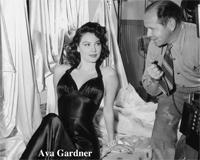
Ava Gardner working with Clarence Sinclair Bull in 1945.
(Photo: John Kobal Foundation)
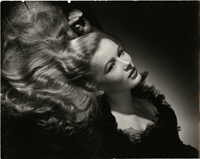
Photographer George Hurrell (1904-1992) photograph, “Veronica Lake,” for Paramount in 1942, 10.5 x 13.5 inches; it sold in March 2009 for $10,755.
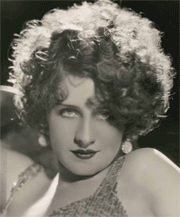
George Hurrell’s photo, "Norma Shearer in Strangers May Kiss," for
MGM 1931, 10 x 13 inches, sold in Nov. 2009 for $6,572.
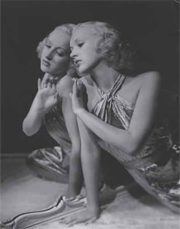
"Betty Grable," Paramount, 1930s, 10 x 13 inches; sold in Nov. 2009 for
$2,390.
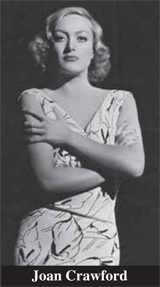
George Hurrell, “Joan Crawford,” MGM, 1930s, 10 x 13 inches; it sold in Nov. 2009 for $2,390.
|